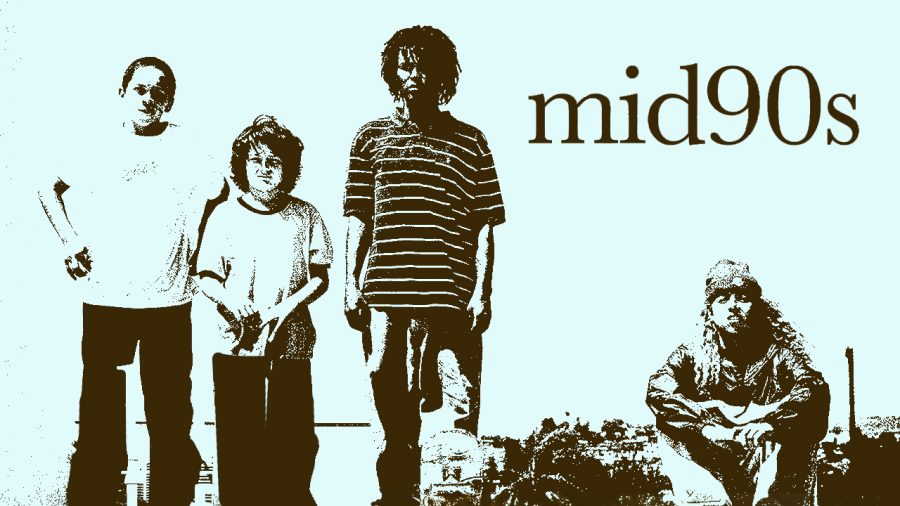Jonah Hill’s directorial debut “Mid90s” opens on a long shot of a hallway. The frame is still and grainy, giving the viewer a moment to adapt to the tight, square-like 4:3 shooting ratio that immediately imbues the film with a classic, vintage feel reminiscent of the 1990s. Then, with no warning, Stevie (Sunny Suljic) flies out of a room and slams into a wall as his brother Ian (Lucas Hedges) rushes out, tumbles on top of Stevie and starts punching him. The scene is raw, striking, and intrapersonal — all sentiments that define this film.
Set in 1990s Los Angeles, the film follows Stevie as he is introduced to the world of skate punks through a group of older boys that he befriends in a skate shop. He becomes almost inseparable from them — they skate together, party together, drink together — despite his mother’s pleaful protests and the painful wounds he incurs while testing the limits of his skills.
Throughout the film, Wu-Tang Clan posters elaborately decorate bedroom walls, a Morrissey song roars to life as boys skate down a Los Angeles street and characters wear T-shirts emblazoned with logos of iconic skate brands. The film is imbued in the iconography of a subculture that took 1990s America by storm. However, its most poignant moments aren’t about skating culture so much as they’re about interpersonal adolescent relationships.
Hill’s youth was spent among the skating community of ’90s Los Angeles. Through his own experience, he adds a level of specificity and nuance to each scene that ultimately makes the story universal. Hill seamlessly alternates tonal shifts, morphing the film into an emotional joyride and fairly closely mimicking the twists and turns of real life.
“By the time we started shooting we were all pretty close friends… It felt really natural,” said Suljic in an interview with Washington Square News, alongside co-stars Olan Prenatt, Ryder McLaughlin and Na-kel Smith.
Smith, who is a professional skateboarder in real life, believes that skateboarding is usually portrayed in an artificial and tacky way but that “Mid90s” does not fall into this trap.
“I wanted to do everything that I could to make sure it wasn’t corny,” Smith said. “I feel like everybody felt that exact same way. That’s why I think it came out so well.”
Whether or not viewers have experienced the ’90s or skate culture firsthand, there is an aspect of “Mid90s” they will be able to relate to — whether it be familial dysfunction or the desire to belong. The film does not fuel itself on nostalgia. Instead, its ’90s atmosphere serves as a reflection of how its central characters see the world. It sets the stage on which these boys come of age and discover truths about themselves and those around them.
“I feel like these are all universal characters that I can connect to and that a lot of people can connect to,” said Prenatt, who plays Fuckshit, one of the leaders of the group. “My character specifically, it was hard … it’s my first time acting so I really had to try hard at acting.”
Despite being newcomers, Prenatt and Smith are effortlessly charming, flowing from scene to scene with magnetic charisma and a fun bravado that make them both standouts of the film.
But Suljic is the real scene stealer. The film is a coming-of-age tale as much as it is a period piece, and it’s impossible to think about how the film could have worked without Suljic in the lead role. Stevie is thrust into mature situations that force him to learn about the complications of friendship, family, sex and skating at an age when most kids are just worried about which cartoons to watch on Saturday mornings. He’s emotionally messy and immature but has an intense curiosity, and Suljic captures this naive ambition beautifully.
“If anything, I want people to walk away from this movie just with a love for their friends and, mainly, just to love your friends and to just be present in everybody’s life,” Smith said.
“Mid90s” is a heartfelt and touching antidote to the seemingly endless tumult of daily life. The film’s last moment is one of its most poignant: a group of friends asleep in a circle. With their eyes closed, all the images of skating, bloody wounds, street fights, screaming, drinking and smoking that craft their tough exteriors are shed. All they really have is each other. And maybe that is enough — that’s all that really matters.
A version of this article appeared in the Monday, Oct. 22 print edition. Email Taylor Stout at [email protected].


























































































































































